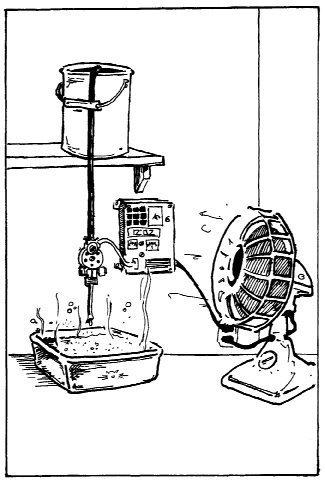Generation of CO2 in
the grow room by dripping vinegar (acetic acid) into a bed of baking soda
is a recent development in the world of indoor gardens. (See drawing.)
This method is best suited for a small closet type operation. There is no
temperature rise, no water vapor is created, and there is no risk of fire.
Although the equipment to generate CO2 chemically is inexpensive, the cost
of the vinegar and baking soda makes this an expensive method.
Compared to timed cycles of exhaust followed by injection, the continuous drip soda/acid method lags far behind injection in its capacity to produce and maintain the optimum levels of CO2 for best growth. This is due to its process of continuous but slow release of CO2.
Assuming that
we are working with a grow area with a timed exhaust cycle, the gas
generated from the continuous drip soda/acid method would start out at
just above the 300 ppm available in the air drawn into the growth chamber
from outside. As the vinegar drips into the soda, CO2 is continuously
formed and the CO2 level in the room rises. It usually takes a
considerable portion of the cycle for the CO2 to build to the point where
it does much good. If the CO2 is generated too rapidly, it can reach
levels where it is detrimental and even toxic to the plants.
Cyclic Vinegar Dump Device
The accompanying illustration shows
a design for a CO2 device that periodically drops an easily regulated
amount of vinegar into a bed of soda. The solenoid operated dump valve
dispenses the vinegar into the soda after completion of the periodic
exhaust cycle. The CO2 generation is safe, rapid, and similar in many
aspects to release of CO2 from a timed injection system.
This system is unavailable
commercially, and I have not tried the design, but construction and
operation should be straightforward.
It is important to find a timer that
permits settings of at least one opening per hour, and will dispense the
vinegar without any pressure.
There are a lot of complex formulas
that can be used to determine how much of what to add how often. The best
bet is to make a rough guess, and then set the system up in the manner in
which it will be operated. Be prepared to take a number of tests with the
glass tube/ syringe CO2 tester. Take the test after the first vinegar
dump, and then adjust the burette or IV bottle by increasing or
decreasing the rate at which it fills to a point where it will contain
more or less vinegar when the next exhaust! vinegar dump cycle
occurs.
The variables in this piece of
equipment (dump cycle and fill rate) are easily controlled. The settings
that produce 1500 ppm one time should do the job pretty much the same way
every time.

